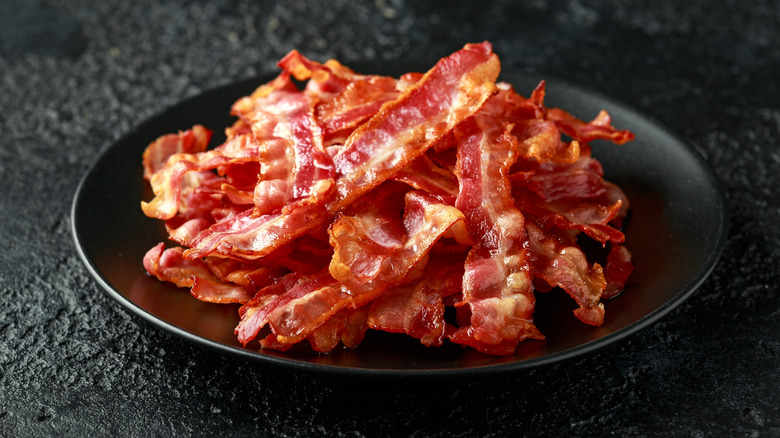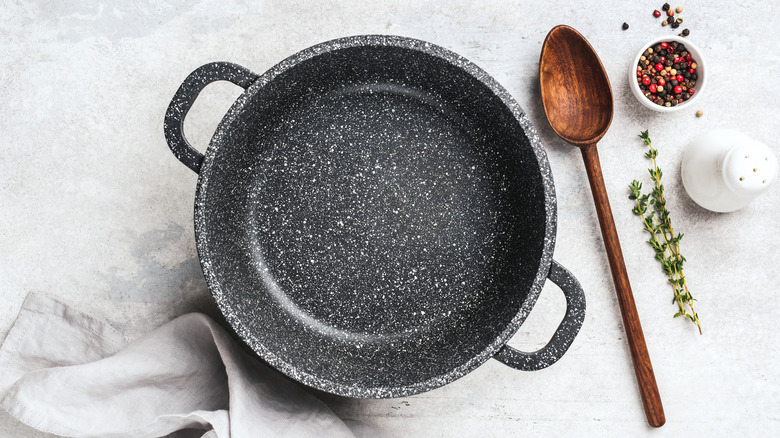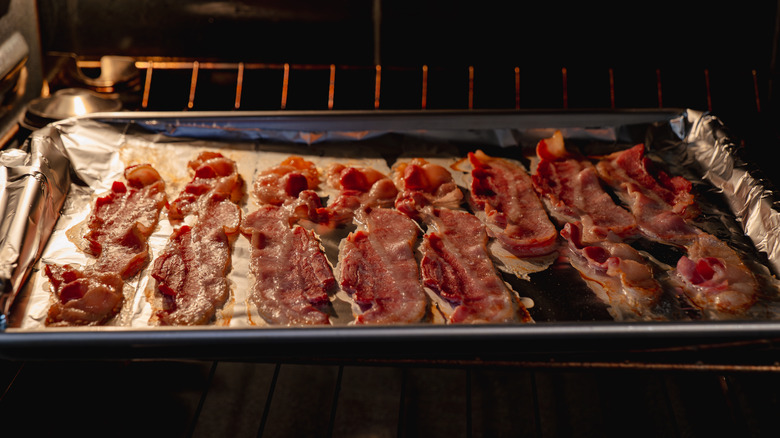Skip The Frying Pan — Cook Bacon In A Pot For A Mess-Free Breakfast
As deliciously crisp as bacon can be, the mess created while cooking it can be off-putting: grease splattered across the stovetop, your kitchen counters, perhaps even the wall behind the stove. Fortunately, you can avoid most (if not all) of this mess by simply changing up the cookware you use.
Rather than using your standard steel skillet, consider switching to a deeper pot. The higher walls will help to contain the majority of the fat splatters, keeping your kitchen clean and your hands safe. Another perk of using a pot is the increased capacity. Rather than cooking a few strips at a time, you can load the pot with a larger amount of bacon. You will have to drain the rendered fat several times, though, and might need to move the strips around more frequently to crisp them up.
Due to the pot being deeper than a frying pan, you may need to use different utensils, too. For instance, you might choose longer grilling tongs over regular tongs to flip the strips efficiently, or you can even use a long-handled spatula. Whichever tool you choose, use it to stir and flip your bacon so both sides of each strip can fully cook.
How does the pot method differ from pan-cooking bacon?
Besides the obvious built-in splatter guard, cooking bacon in a pot doesn't work much different from cooking it in a skillet. Both pieces of cookware work well over medium heat and allow the optional addition of a lid, which can trap steam and further tenderize your bacon.
Just like when you cook bacon in a pan, you don't need to use extra oil to cook bacon in a pot. Instead, start with a cold pot to keep the bacon from sticking, and let the fat slowly melt away into a sufficient layer of grease as the pot gets hot and the bacon begins to sizzle. However, you don't want to start with cold bacon, because it can lead to uneven cooking. A cold pot, plus bacon that's had a minute to warm up outside of the fridge, will equal success.
Lastly, the type of pot you use is just as important as the type of skillet you select. In most cases, your best bet will be a thick-bottom cast iron pot. Cast iron is already the best kind of pan for cooking bacon, as the material further prevents sticking and is heavy-duty enough to stand up to the heat (not to mention the long cook time) needed for perfectly crispy bacon. The same goes for a cast iron pot.
Other ways to reduce bacon grease splatters
A potential downside to cooking bacon on the stove — no matter which vessel you use — is how much effort it takes. You have to stand by the stove the entire time, flipping the pieces and monitoring them closely to make sure they don't burn, all while dodging splashes of hot grease. Fortunately, there's a hands-off approach that's even easier than the pot method: use your oven.
Simply lay out your bacon on a cookie sheet (don't forget the parchment paper for easier cleanup!), then place it in the oven to cook. Approximately halfway through your cook time, flip each piece of bacon. Just like that, you've got a whole load of evenly-cooked, crispy bacon without the excessively splattering or constant maintenance. Yes, your oven might get a little greasy, but any mess will be kept to a contained environment, and there's a much smaller chance of burning yourself.
If you have an air fryer, this appliance is also an excellent alternative to cooking bacon using the stove or oven. You can use it similarly to an oven, and again, make sure to line your frying drawer with tin foil or parchment paper. Keep in mind that the air fryer won't be able to handle as much bacon as an oven, but the strips may cook faster, and your air fryer might be easier to clean.



